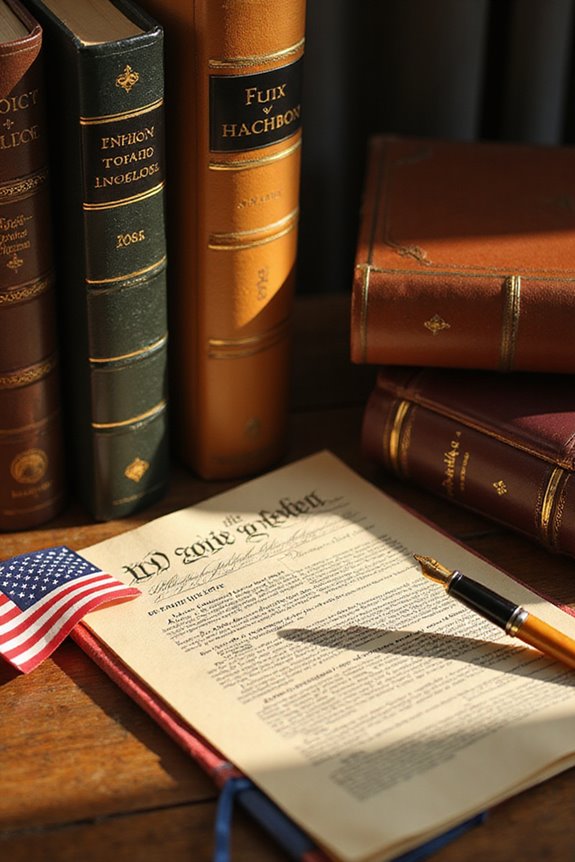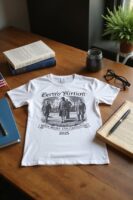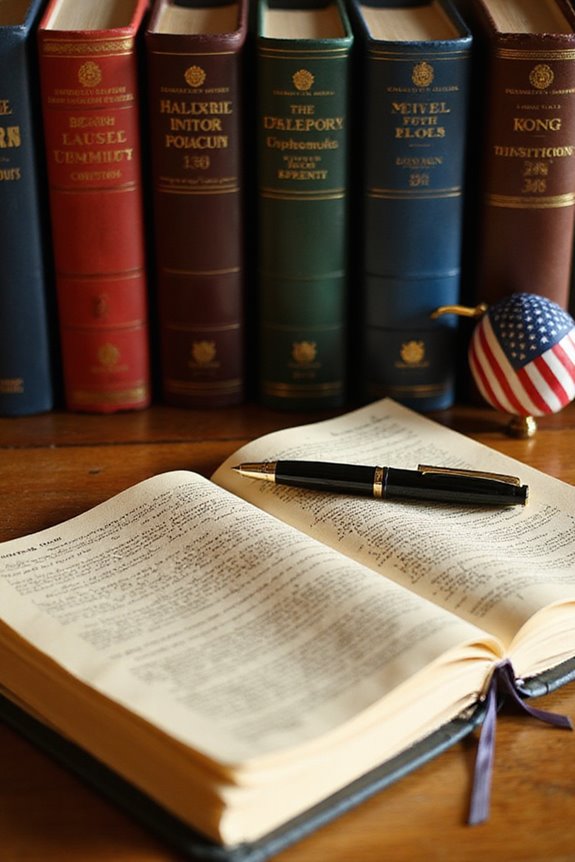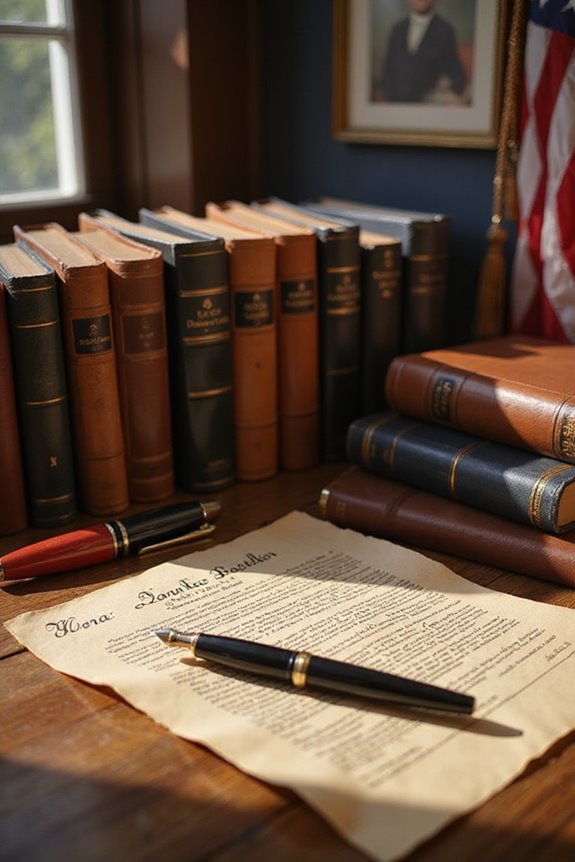Here are some essential political books that explore voting rights:
- “Give Us the Ballot” by Ari Berman: This book examines the history and future of voting rights in America.
- “The Fight to Vote” by Michael Waldman: It highlights key moments in the struggle for voting access.
- “The Myth of Seneca Falls” by Lisa Tetrault: This work critiques the oversimplified narratives of women’s suffrage.
- “For Freedom’s Sake” by Chana Kai Lee: A biography of Fannie Lou Hamer’s impactful activism.
These texts provide valuable insights into voting rights progress and challenges. If you’re interested, further exploration of these topics can enhance your understanding.
Key Takeaways
- “The Voting Rights Act of 1965: The Legacy and Impact” examines the historical significance and ongoing relevance of this landmark legislation.
- “One Person, No Vote” by Ari Berman explores modern voter suppression tactics and their effects on democracy and civil rights.
- “The Women’s Hour” by Elaine Weiss chronicles the final push for women’s suffrage, highlighting key figures and grassroots activism in the movement.
- “Give Us the Ballot” by Ari Berman discusses the historical struggle for voting rights and the contemporary challenges faced by marginalized communities.
- “Voting Rights Under Fire” by Richard L. Hasen analyzes the ongoing threats to voting rights and the legal battles surrounding them today.
“Give Us the Ballot” by Ari Berman
In “Give Us the Ballot,” Ari Berman examines the intricate landscape of voting rights in America, emphasizing the historical significance of the Voting Rights Act of 1965.
- The book chronicles the transformation in American democracy post-VRA while highlighting ongoing struggles to secure voting rights. The author emphasizes the importance of historical context in understanding the evolution of voting rights legislation.
- Berman details voter mobilization strategies that emerged from grassroots activism, showcasing how communities organized to combat voter suppression.
- He also documents the challenges posed by new laws designed to restrict minority voting access, illustrating the continuous fight for equitable representation.
- Through archival research and interviews, Berman connects historical movements to contemporary issues, reinforcing that the battle for voting rights remains essential to American democracy today. The author also sheds light on the ongoing battles over voting rights that persist 50 years later.
This work serves as a critical reminder of the ongoing importance of voter participation and advocacy.
“The Fight to Vote” by Michael Waldman
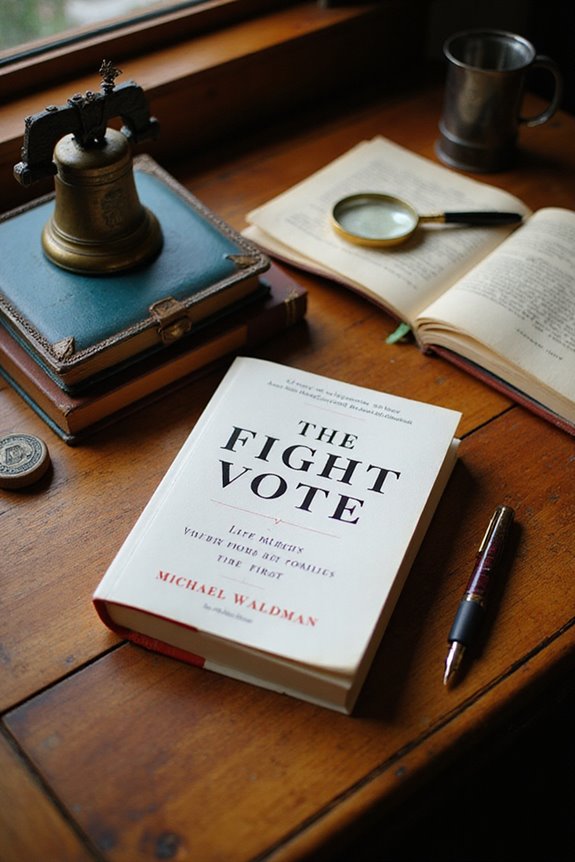
Michael Waldman’s “The Fight to Vote” provides a thorough analysis of the ongoing battle for voting rights in the United States.
- Waldman’s arguments highlight the historical context of voting struggles, from early skepticism of democracy to modern-day challenges. He explores how foundational concepts in political economy influence the political landscape surrounding voting rights and accessibility.
- He examines how amendments like the Fifteenth and Nineteenth sought to expand voting accessibility, yet loopholes continue to allow discrimination. Voting rights were left to individual states, leading to significant disparities in access across the country.
- The Voting Rights Act of 1965 marked a significant milestone but faces ongoing threats through voter ID laws and roll purges.
- Waldman emphasizes grassroots movements and the need for continued advocacy to guarantee that marginalized communities have equitable access to the ballot.
- He proposes reforms such as automatic voter registration and expanding early voting, reinforcing the importance of public awareness in safeguarding voting rights.
“The Myth of Seneca Falls” by Lisa Tetrault
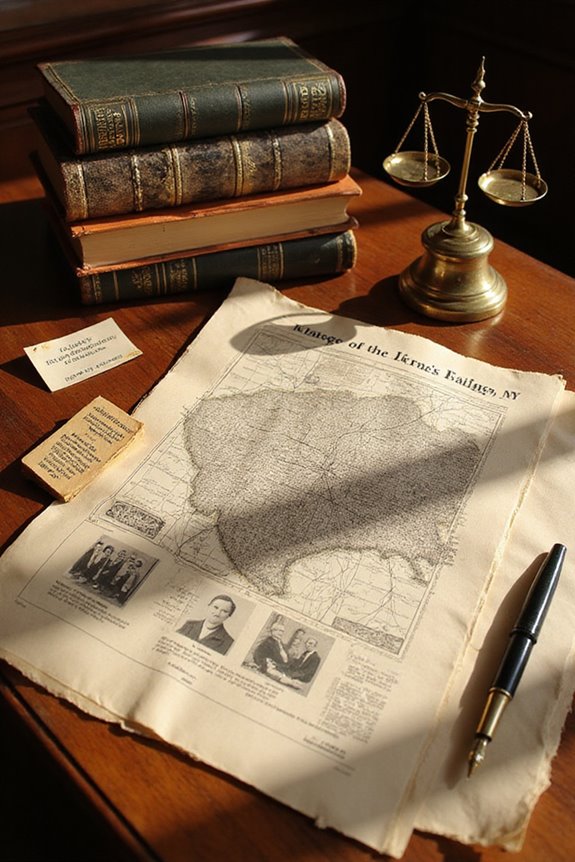
Lisa Tetrault’s “The Myth of Seneca Falls” examines the commonly held belief that the Seneca Falls Convention was the sole beginning of the women’s suffrage movement in the United States.
- Myth versus Reality: Tetrault critiques the mythified narrative surrounding Seneca Falls, arguing that it oversimplifies the evolution of women’s rights activism.
- Key Figures: Figures like Elizabeth Cady Stanton and Frederick Douglass played pivotal roles, but they are part of a larger story. Additionally, the book highlights the importance of accountability in activism, showcasing how these leaders were influenced by and accountable to broader social movements.
- Historical Narratives: The book contextualizes the convention within broader feminist movements, revealing other significant events and contributions. Additionally, Tetrault emphasizes that women involved in the abolitionist movement became leaders in the women’s rights movement, showcasing the interconnectedness of various social reforms.
- Impact: By challenging traditional accounts, Tetrault refines our understanding of women’s suffrage and its historical significance, emphasizing the need for a nuanced interpretation of activism.
“For Freedom’s Sake: The Life of Fannie Lou Hamer” by Chana Kai Lee
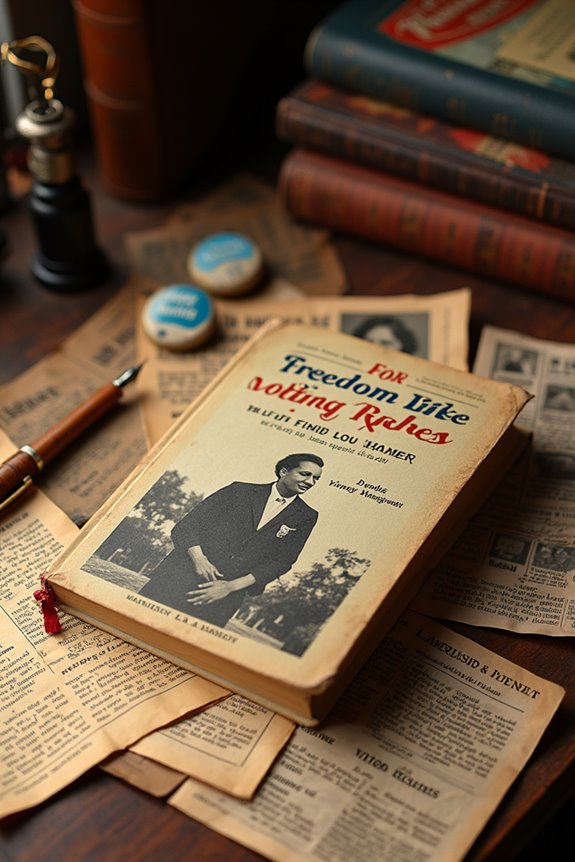
Chana Kai Lee’s “For Freedom’s Sake: The Life of Fannie Lou Hamer” presents a thorough account of Hamer’s significant contributions to the voting rights movement.
- Hamer’s activism began in 1962 when she learned about her legal right to vote, igniting her commitment to challenging systemic barriers. This dedication to inclusive political institutions highlights the necessity of equitable access to the democratic process.
- She faced severe risks, including job loss and physical violence, yet remained persistent in her efforts to register Black voters.
- Co-founding the Mississippi Freedom Democratic Party, she challenged white political dominance, drawing national attention at the 1964 Democratic National Convention. Her efforts were instrumental in the passage of the 1965 Voting Rights Act.
- Hamer’s grassroots organizing was pivotal in raising awareness that contributed to the Voting Rights Act of 1965.
- Her legacy impact continues to inspire future generations fighting against voter suppression and advocating for civil rights.
Victory for the Vote
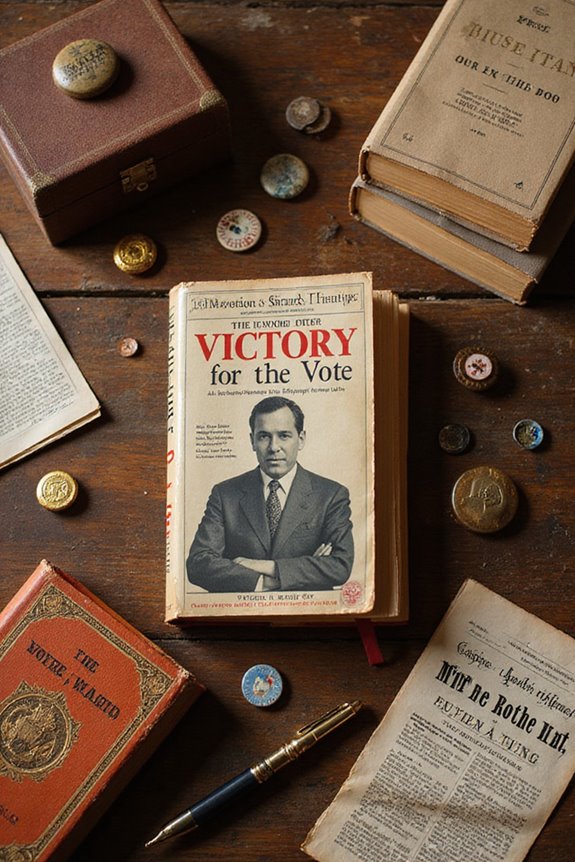
“Victory for the Vote” by Doris Weatherford offers a thorough examination of the women’s suffrage movement in the United States, detailing its evolution from the early 17th century to the landmark passage of the 19th Amendment in 1920.
- The book highlights key suffrage milestones and major figures like Elizabeth Cady Stanton and Susan B. Anthony.
- It chronicles grassroots activism strategies that shaped the movement, including coalition-building with civil rights activists. Additionally, Weatherford’s analysis reflects the broader theme of power dynamics that influenced various social movements in history.
- Weatherford also emphasizes the philosophical roots tied to Enlightenment ideals of equality and justice.
- Importantly, the text addresses the ongoing challenges women faced after 1920, reminding us that the struggle for genuine equality continues today. Furthermore, the book connects to the idea that every vote is a prayer, reinforcing the importance of civic engagement in the pursuit of equality.
Through its detailed narrative, this book serves as an essential resource for understanding the complexities of the suffrage movement.
“Lillian’s Right to Vote” by Jonah Winter
“Lillian’s Right to Vote” by Jonah Winter offers a poignant exploration of the historical struggle for voting rights through the eyes of a centenarian.
- The narrative centers on Lillian, a 100-year-old African American woman, reflecting on her family’s long journey toward voting rights.
- Lillian’s Legacy is depicted through her memories of her ancestors’ experiences, including her great-grandfather’s voting after the Fifteenth Amendment.
- She recalls her parents’ challenges with voter registration, alongside her own involvement in civil rights protests like the Selma to Montgomery marches.
- The uphill walk symbolizes the ongoing struggle against voter suppression tactics, illustrating the persistence required to secure voting rights for Black Americans since they were not fully secured until 1965.
- This book serves as an educational tool, introducing younger audiences to the complexities of Lillian’s Voting Journey and the broader civil rights movement.
Historical Context of Voting Rights
The historical context of voting rights in the United States reveals a complex evolution shaped by various legal and social factors.
- Early voting history primarily favored white male property owners, with limited exceptions for women and free Black men in some states.
- After the Civil War, the 14th and 15th Amendments aimed to secure rights for formerly enslaved individuals, yet Jim Crow laws undermined these efforts.
- The women’s suffrage movements gained momentum in the 19th century, culminating in the 19th Amendment, which granted women the right to vote in 1920.
- The 20th century brought significant federal protections, including the Voting Rights Act of 1965, which outlawed discriminatory practices and increased political participation among minorities. State voting laws were often influenced by local attitudes and prejudices, further complicating the landscape of voting rights.
Understanding this context helps us appreciate the ongoing struggle for equitable voting rights.
Key Figures in the Voting Rights Movement
As we explore the key figures in the voting rights movement, it’s important to recognize their diverse backgrounds and contributions.
- Susan B. Anthony and Carrie Chapman Catt utilized suffragist strategies to advocate for women’s voting rights, emphasizing education and empowerment. Their efforts laid the groundwork for later legislation, including the Voting Rights Act of 1965, which aimed to eliminate racial discrimination in voting.
- Frederick Douglass and Jane Addams linked civil rights to political activism, promoting African American suffrage and social reform.
- Leaders like Dr. Martin Luther King Jr. and John Lewis mobilized national support during the Civil Rights Movement, especially through events like the Selma marches.
- Septima Poinsette Clark and Fannie Lou Hamer focused on grassroots efforts to register voters.
- Ida B. Wells-Barnett and Mary Church Terrell highlighted the intersection of race and gender in the suffrage movement, advocating for equal rights for all.
Current Challenges and Future of Voting Rights
Current challenges to voting rights have emerged as significant threats to democratic participation across the United States.
- Voter suppression tactics, such as the SAVE Act, impose legislative barriers that disproportionately affect marginalized communities, particularly Black and Native American voters.
- Executive orders, like those from Project 2025, risk disenfranchisement by requiring unnecessary documentation for voter registration, complicating voter accessibility.
- Shifting enforcement of voting-related offenses could criminalize civic engagement, further deterring political participation due to fear of prosecution. Additionally, the potential undercounting of Black populations due to political interference in the census could severely impact resource allocation and representation for these communities.
- The potential politicization of the 2025 Census threatens accurate representation and resource distribution for undercounted populations.
- These trends highlight urgent disenfranchisement issues that undermine electoral integrity and necessitate collective advocacy for robust voting rights protections.
Frequently Asked Questions
How Do These Books Address Intersectionality in Voting Rights?
Did you know that Black women are three times more likely to face voter suppression? Through intersectional analysis, these books amplify marginalized voices, revealing how intertwined race and gender complexities continue to challenge voting rights today.
What Are the Most Notable Case Studies Presented in These Works?
When exploring notable case study examples, we see Fannie Lou Hamer’s activism, the Voting Rights Act’s impact, and women’s suffrage. Each case highlights the ongoing struggles for equity and representation in our electoral process.
Are There Any Recommended Companion Resources for Further Reading?
If you’re seeking companion readings and additional resources, we recommend exploring titles like “Victory for the Vote” and “A Century of Votes for Women” for deeper insight into the history of voting rights.
How Have These Books Influenced Contemporary Voting Rights Activism?
As we explore the literary impact of these works, their influence on activism evolution becomes clear; they inspire grassroots movements, igniting passion for voting rights and reminding us that history shapes our fight for tomorrow’s democracy.
What Writing Styles Are Used by the Authors in These Books?
In exploring writing styles, we notice diverse narrative techniques and persuasive rhetoric. These elements engage readers by blending storytelling with factual analysis, making complex issues accessible and motivating us to reflect on our democratic responsibilities.

